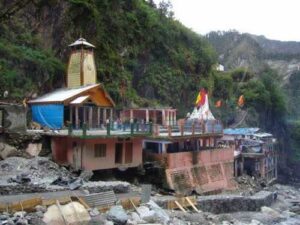
On the western side of Garhwal Himalayas, in the Uttarkashi district of Uttarakhand, lies the holy place of Yamunotri. About 3,293 metres above the sea level, Yamunotri stands proudly with its enormous mountain peaks, glaciers and gushing waters of Yamuna. River Yamuna, the second most sacred river of India, originates in Yamunotri, making it one of the pilgrimage sites in the Chota Char Dham Yatra in Uttarakhand.
The venerated goddess Yamuna is said to be the daughter of Sun and twin sister of Yama (the god of death); in Vedas, Yamuna is called Yami (lady of life). A bath in the sanctified waters of Yamuna is said to cleanse all sins and protect from untimely or painful death. Such strong associations in Hindu mythology place Yamuna Devi (goddess) in high ranks of divinity.
The River Yamuna originates from the Yamunotri glacier, which rises up to 6,315 meters above sea level, and lies against a steep slope just below the top of the Kalind peak. From here Yamuna comes down into Saptarishi Kund and from there gushes southwards in a series of waterfalls. To the west of the Kalind Parbat is located Banderpoonch, which is a dominant mountain in central Himalayan area of Garhwal and divides the watershed of Yamuna from that of the Ganges. Coming out from Kalind Parbat, Yamuna is also known as Kalindi.
As per a legend, Lord Hanuman doused the fire of his tail after burning Ravan’s Lanka in the chilly waters of Yamuna at Banderpooch. That is why the peak is called Bander (monkey) Pooch (tail) – monkey’s tail. Another legend sees Yamunotri as the hermitage of ancient sage Asit Muni. The Muni used to bath both in Yamuna and Ganga, but in his old age he couldn’t travel to Gangotri. Realising his problem, a stream of Ganga started to flow beside that of Yamuna.
Yamunotri Temple
The holy abode of Goddess Yamuna is situated near the foot of Kalind Parbat (peak) and on a side of Banderpoonch Parbat. Nestled in the intimidating Himalayas, Yamunotri temple is believed to be constructed by the king of Tehri, Naresh Sudarshan Shah in 1839. Yamuna River jets down from one side of the temple.
This temple is built in the Nagar pattern of architectural style. The temple is built by granite stones that are sourced from the surrounding mountains. The steps and the stone blocks that are used to construct the access path to the temple is made from the nearby rocks.
The top of the temple contains a medium conical shaped minaret. The minaret is pale yellow colored with bright vermillion border. A small porch sized structure is placed in front of the temple and is joined with the beautiful main entrance.
The deity or Goddess Yamuna is made of black marble. The temple is dedicated to the river Yamuna, who is represented in the form of a silver idol, bedecked with garlands. Ganga Devi too finds her place, in white stone, by the side of Yamuna.
The Yamunotri temple opens in the month of April/May at the onset of the summer season and closes for winters in the third week of November. The idol of Goddess Yamuna is then carried to Kharsali Village where the pilgrims can pay homage to the deity for 6 months. The dates for opening date of Shri Yamunotri Temple is announce by the priests on the auspicious day of Basant Panchmi. Both closing and opening ceremonies of the Yamunotri shrine are brought about with celebrations, elaborate rituals and vedic chants.
Very near to the Yamuna Devi temple there are many hot water springs; the most significant among them is the Surya Kund. It holds the boiling-hot water as it emerges from the crevices in the mountain. People boil rice and potatoes by tying them in a cloth (preferably muslin cloth) and consider them a Prasad (religious offering) from Goddess Yamuna.
Ritual duties such as the making and distribution of prasad (sanctified offerings) and the supervision of pujas (ritual venerations) are performed by the Uniyal family of pujaris (priests).
The Suryakund is also the setting for an important Shila (rock) is called the Divya Shila that is worshiped before Puja is offered to the goddess Yamuna. According to Skanda Purana, with a mere touch of this sacred rock one can attain spiritual liberation.
Source:
https://www.chardham-tours.com/yamunotri-temple/
https://www.sacredyatra.com/yamunotri-temple.html
https://www.tourmyindia.com/chardham/yamunotri-dham.html
https://en.wikipedia.org/wiki/Yamunotri_Temple


